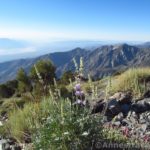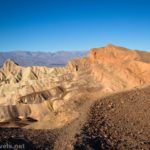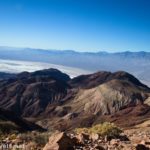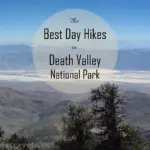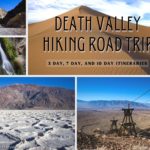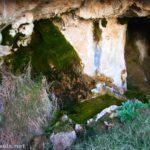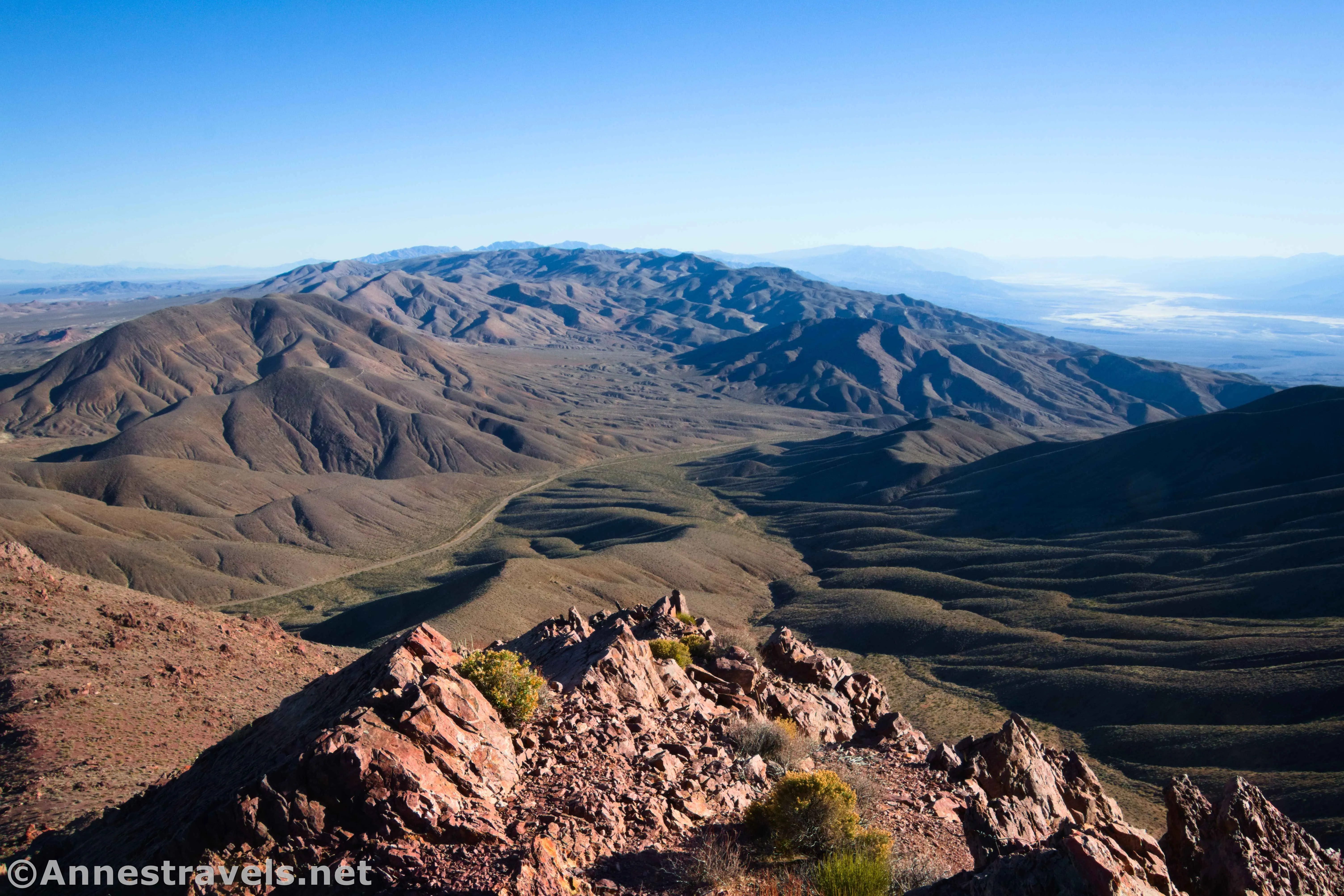
In my ramblings around the internet looking for cool hikes to add to my ever-growing site about Death Valley National Park, I ran across the fact that I could hike to the top of an unnamed mountain called Daylight Peak above Daylight Pass. The route, so the reports said, began at Daylight Pass and climbed up the scree on the side of the mountain. It was only 2 or 3 miles round trip, and it hadn’t been decimated by Hurricane Hillary, so it seemed like a natural place to check out on my trip to the park last fall. It turned out to be significantly harder than we expected, but the views were also exceptionally better than we expected – so if you’re up for a very steep, scree-filled climb and are used to wayfinding and hiking off-trail in the desert, I highly recommend it!
Quick Stats
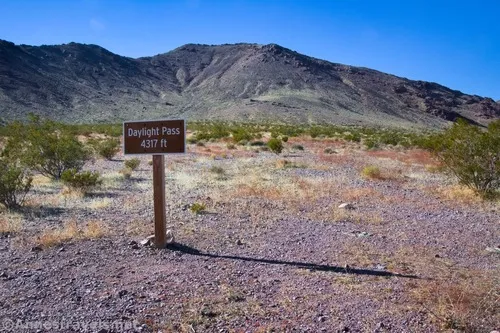
There is a pulloff at the top of Daylight Pass. At the edge of the very middle of the pullout is a sign announcing your current destination and elevation. Begin next to the sign, heading straight out into the desert. You’re actually following an old road, which you’ll probably run across about the time you come to an old spigot.
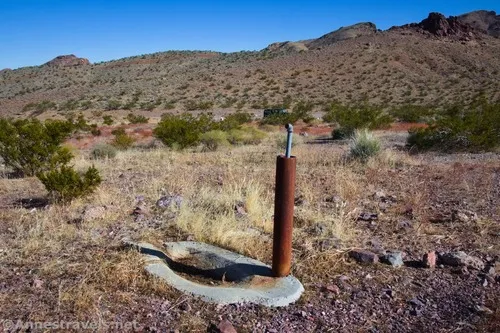
Continuing straight into the desert, follow the old road. Step over a wire between two metal posts (this blocked the road at one time) and continue on the road to where it ends just before Daylight Spring.
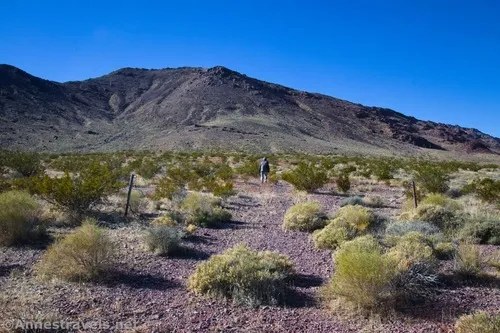
Even just at the end of the road, the views are pretty good. The Funeral Mountains to the south (across Daylight Pass) are colorful, and there are some color and good views east toward Beatty.
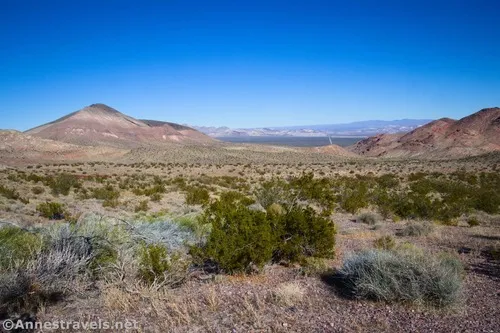
The spring itself was a bit of a disappointment. I saw no water, just a tangle of brush. I suppose I expected as much, but it still was very much a “ho-hum, who cares?” kind of destination. Near early morning or evening, there might be wildlife in the area which would have improved its excitement factor a lot.
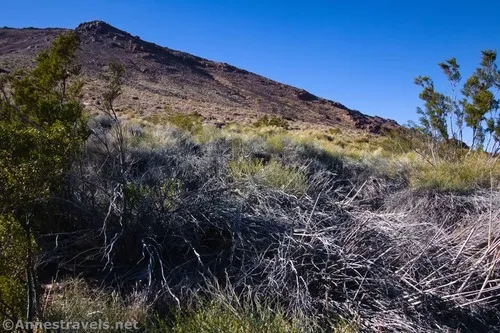
From here, we turned left (compared to the direction we had been walking – in other words, we had been hiking north, and now we turned west) to begin up the lower slopes of Daylight Peak. The higher we climbed, the better the view became, especially to the east.
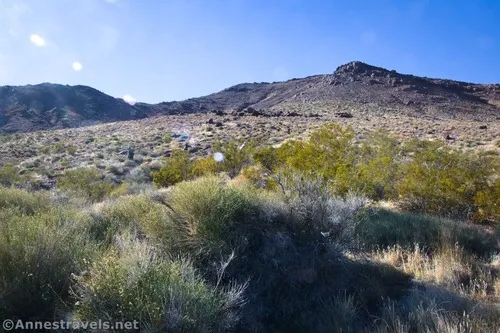
We tried to follow the terrain, rising slowly up the more northerly (eastern) arm of the mountain. That worked for a while, but pretty soon we were forced to head up very steep scree slopes, trying not to get into the sheer rocks on top of the arm. It was sketchy and required some very good scree skills due to the steepness. Thankfully, this wasn’t my group’s first time doing crazy stuff on talus. Even so, we all slipped and slid at least once if not more.
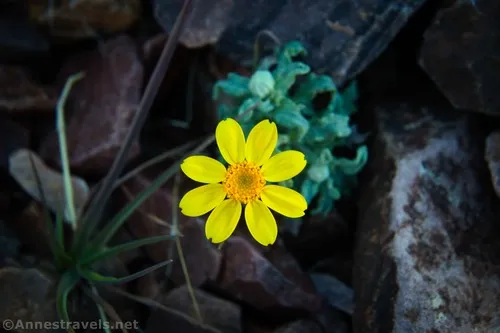
When we stopped to catch our breath, the view was great, or else we could look up to the top of the arm to the red rock formations. We also saw a cyber truck on the Daylight Pass Road – it seemed to go out to Rhyolite or Beatty and then return an hour or so later. It was the first cyber truck we’d seen in real life, and all of our comments went something like, “It’s not as ugly in real life as in the models!”
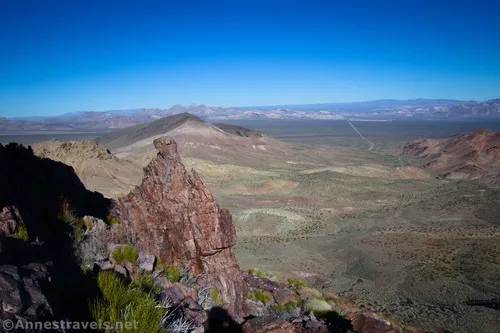
A mile from the parking area, we finally reached the top of the arm in a saddle just to the left of the red rock formations. From here, it was an easy (and pretty) Class 2 hike up to the summit block!
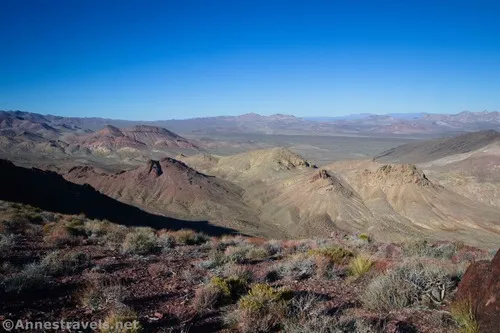
The views from Daylight Peak are fantastic. To the east, the Daylight Pass Road stretches down into the valley with US-95 and Beatty. To the north is the Grapevine Mountains, including several colorful hills. Titus Canyon is over there, too, but it’s blocked by nearby mountains.
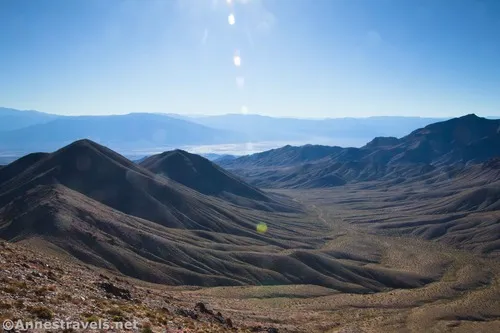
To the west, you can see the Mesquite Sand Dunes and CA-190 heading up toward Towne Pass – north of the road are the Cottonwood Mountains, while the Panamint Mountains (including Telescope Peak) are to the south. I think I might have seen some of the craggy peaks of the Sierra Nevadas to the west, as well.
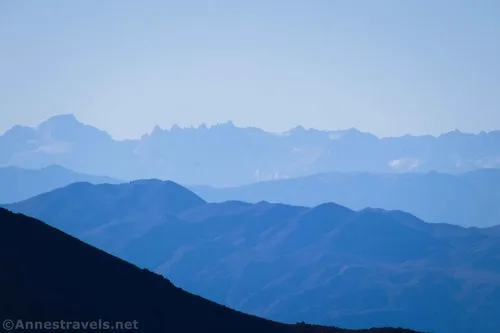
South of Daylight Peak, you can see down Death Valley to Badwater as well as gorgeous views of the Funeral Mountains. The Chloride Cliffs Road is visible through the mountains, though I don’t think you can see the cliffs, themselves. Honestly, it’s just a great view any way you look!

We found the summit register, entered our names, and then scrambled south along the ridgeline to a second peak. It was not exactly an easy scramble, but it seemed pretty good after the steep ascent! Views were also outstanding from this lower peak, though I think the higher one had a better view overall.

For our descent, we decided to go back to the point where we had reached the ridgeline (since all of that was fairly easy hiking) and then drop pretty much straight down the scree, using whatever watercourses we encountered along the way. This was a good plan, and I’d say most people also ascend straight up – I found multiple light social trails and a few footprints. Once at the bottom of the mountain, head generally in the direction of Daylight Pass to intersect the old road; follow this back to the paved road/pullout.
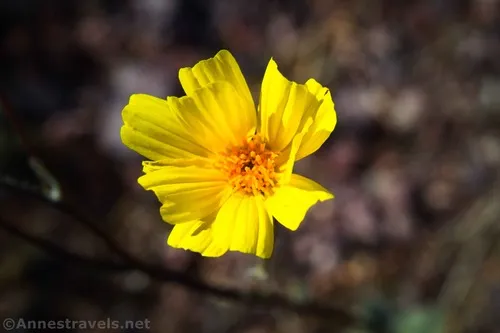
We made it back to the van in one piece (not that it was ever truly in doubt, but those were some very steep slopes!) just in time to drive down the newly repaired Daylight Pass Road to another off-trail adventure – Hole in the Rock Spring – before it got dark!
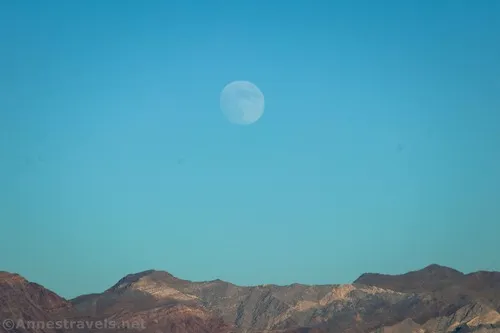
Round Trip Route Length: I went 2.5 miles – you could probably cut a quarter mile off of that if you don’t visit the second lower peak.
Elevation Gain: 1,338ft. (4,321ft. to 5,517ft.)
Facilities: None
Fees: $30/vehicle, valid 7 days. America the Beautiful National Parks & Federal Lands Passes and Death Valley Annual Passes are accepted.
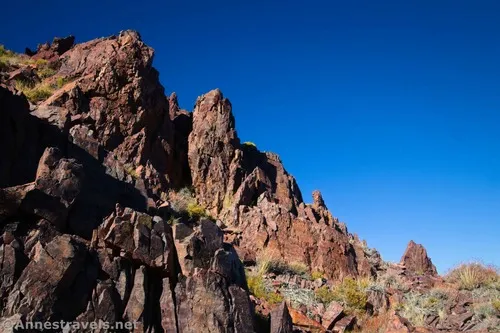
Trail Notes: This is not a trail for the faint of heart, nor is it for the un-sure of foot. The scree is serious business, not just on the way up (when you might find yourself gasping for breath) but also on the way down (when the mountainside might slide out from underneath you). You should be very experienced in off-trail navigation and in climbing very steep slopes without a trail before attempting this hike. Daylight Peak is almost 5,500ft. above sea level, but it’s also very exposed and hot. I visited in November, which seemed to be a good time of year. April-October would be miserable, even with the higher elevation than, say, Badwater Flats. The water in the spring is non-potable. Do your best to leave no trace for the people who hike after you!

Trail 




Road 




Signs 




Scenery 




Would I go 100 miles out of my way for this? 




Overall Rating: 





GPS Coordinates for Daylight Peak
TH: 36.7887710°, -116.9319930° (36°47.32626′, -116°55.91958′ / 36°47’19.5756″, -116°55’55.1748″) (4,315ft.) (0.0)
Water tap: 36.7886470°, -116.9328620° (36°47.31882′, -116°55.97172′ / 36°47’19.1292″, -116°55’58.3032″) (4,350ft.) (334ft.)
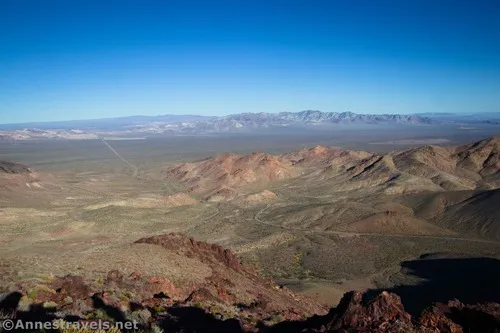
Gate: 36.7886700°, -116.9334570° (36°47.32020′, -116°56.00742′ / 36°47’19.2120″, -116°56’00.4452″) (4,374ft.) (0.10)
Spring: 36.7889050°, -116.9359630° (36°47.33430′, -116°56.15778′ / 36°47’20.0580″, -116°56’09.4668″) (4,437ft.) (0.25)
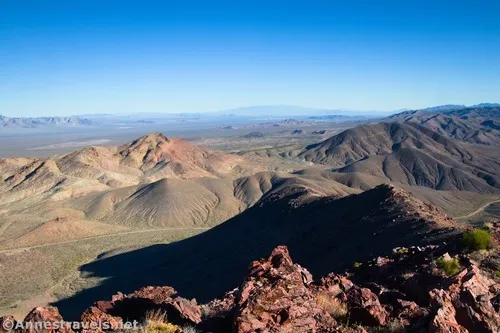
Spring: 36.7891610°, -116.9366800° (36°47.34966′, -116°56.20080′ / 36°47’20.9796″, -116°56’12.0480″) (4,461ft.) (0.31)
Ridgeline: 36.7880450°, -116.9441710° (36°47.28270′, -116°56.65026′ / 36°47’16.9620″, -116°56’39.0156″) (5,364ft.) (1.06)
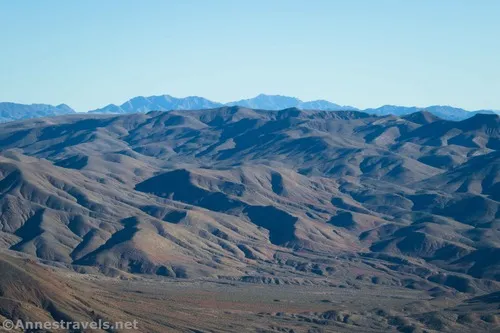
Daylight Peak: 36.7871190°, -116.9456090° (36°47.22714′, -116°56.73654′ / 36°47’13.6284″, -116°56’44.1924″) (5,492ft.) (1.21)
Lower peak: 36.7857700°, -116.9452670° (36°47.14620′, -116°56.71602′ / 36°47’08.7720″, -116°56’42.9612″) (5,489ft.) (1.33)
End: 36.7887500°, -116.9320100° (36°47.32500′, -116°55.92060′ / 36°47’19.5000″, -116°55’55.2360″) (4,316ft.) (2.52)
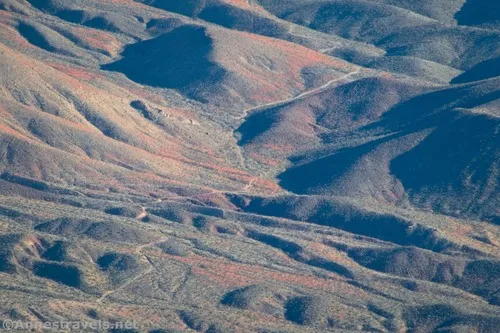
The gpx file for Daylight Peak can be downloaded – please note that this and the GPS Coordinates are for reference only and should not be used as a sole resource when hiking this trail. Also note that I forgot to start the GPS track until I was partway up the peak. My apologies for any confusion this might cause.
Download GPX File size: 80.5 KB Downloaded 225 times
(Note: I do my best to ensure that all downloads, the webpage, etc. are virus-free and accurate; however, I cannot be held responsible for any damage that might result, including but not limited to loss of data, damages to hardware, harm to users, from use of files, information, etc. from this website. Thanks!)
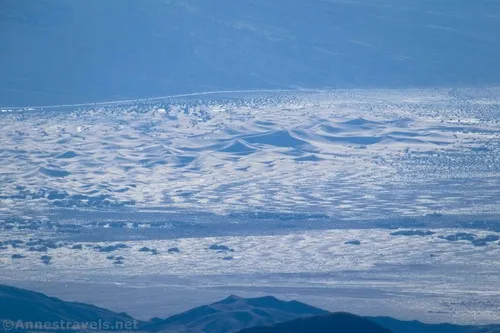
Getting to the Daylight Peak Trailhead (Daylight Pass)
From US-95 in Beatty, Nevada, head west on NV-374 toward Death Valley National Park. Enter California after 12.8 miles; continue another 0.4 miles to the very top of Daylight Pass. Use the pulloff on the right as your trailhead.
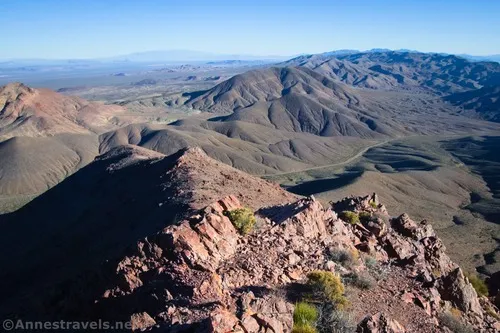
From the Death Valley National Park Visitor Center at Furnace Creek, drive north (west) on CA-190. After 10.6 miles, turn right onto the Beatty Cutoff Road. The road will ascend for nearly its entire 10 mile length, finally dropping you on the Death Valley Road at Hell’s Gate (across the road is a sign kiosk and primitive restroom). Turn right here to continue your ascent. Drive 6.2 miles to the very top of Daylight Pass. Use the pulloff on the left as your trailhead.
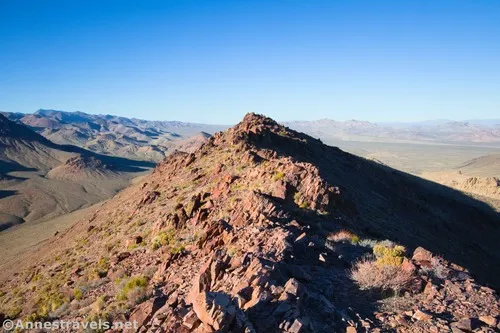
From the Stovepipe Wells Ranger Station, turn left onto CA-190 to head east. After 7.1 miles, turn left onto Scotty’s Castle Road (sometimes called the North Highway). Take the first right (0.6 miles later) onto the Daylight Pass Road. Drive 12.8 miles to the very top of Daylight Pass. Use the pulloff on the left as your trailhead.
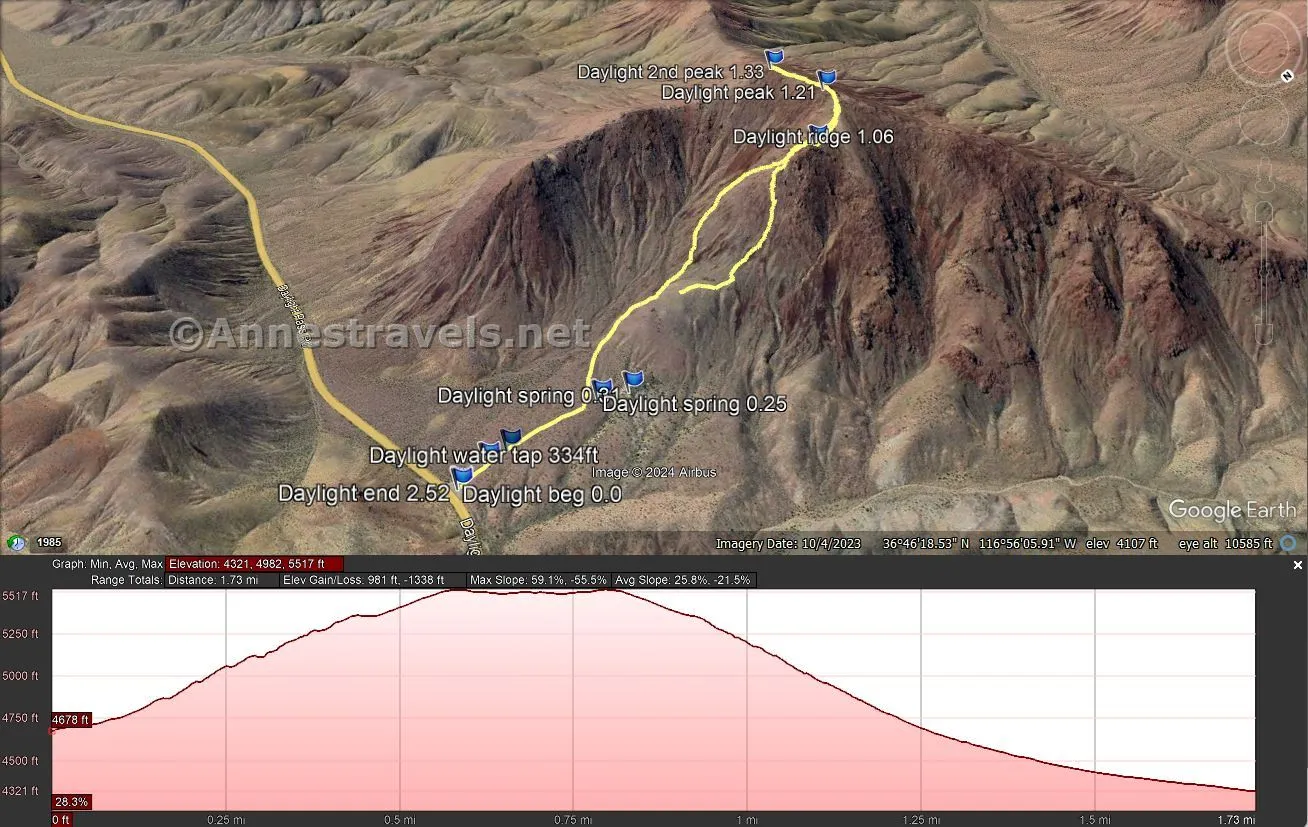
Today’s Featured Product!
Readers often call this the best guide to Death Valley, and with good reason. There are so many maps, photographs, and adventure opportunities packed into its pages. You’re sure to find everything from easy strolls on trails to multi-day trips through the wilderness. Buy your copy here!


